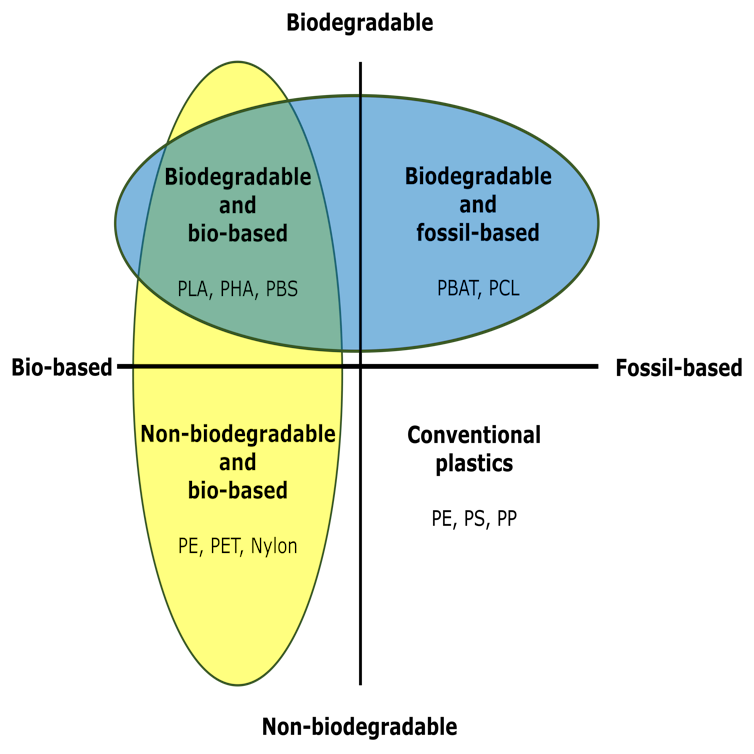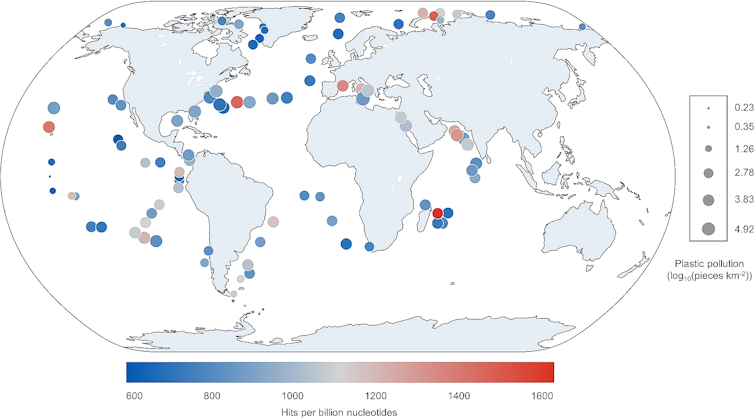Marine plastic pollution is a major environmental issue, with 170 trillion pieces of plastic floating in the world’s oceans. This highlights how urgently we need to develop strategies to deal with this environmental crisis.
We know some microbes can break down certain plastics, but our new research doesn’t see a clear correlation between levels of plastic pollution and the production of plastic-degrading enzymes by marine microbes.
To address this issue, we need to understand the different properties and environmental impacts of different types of plastic.
Most plastics are not biodegradable
There are four main types of plastic: biodegradable, bio-based, fossil-based and non-biodegradable. Those terms can be confusing and lead to misunderstandings about their environmental impact.
Biodegradable plastics can be broken down naturally through the action of living organisms such as bacteria. They are made from renewable sources such as corn starch or sugar cane and do not last long in the environment. Examples of biodegradable plastics are polycaprolactone (PCL), polylactic acid (PLA) and polyhydroxybutyrate (PHB).
Bioplastics are also derived from natural materials such as plants. These plastics include polyethylene terephthalate (PET), which is widely used for clothing and containers for drinks and food. However, although PET can be made from renewable sources, most of its production comes from fossil fuels.
Fossil-based plastics are made from oil and gas. They include common types such as polyethylene (PE), which is used for single-use food packaging, and polyvinyl chloride (PVC), which is commonly used for water pipes and wire insulation.
These plastics are generally non-biodegradable. They are non-biodegradable and can persist in the environment for centuries, contributing significantly to environmental pollution and global warming.

Victor GambariniCC BY-SA
PE is the most widely produced type of plastic in the world. It accounts for 103.9 million tons (mmt) per year, followed by PET (65.4 mmt) and PVC (50.5 mmt). However, in the world only 9% of all plastic waste is recycled.
According to Plastics NZ, terms such as “bioplastic”, “biopolymer”, “bio-based” and “biodegradable” are used interchangeably, although they mean completely different things.
Marine microbes cannot break down plastic
Our research analyzed the genetic information from marine micro-organisms, using data from hundreds of water samples collected during the expedition.
This gave us insights into the genes used by marine bacteria to make enzymes, including what they use to break down some plastics. We can then monitor these enzymes in use at any time.
The idea is that if marine microorganisms break down plastic, they should produce enzymes that can do it. So, if microbes are the biodegrading plastics in our oceans, areas with more plastic pollution should have higher levels of enzymes for plastic degradation.

Victor GambariniCC BY-SA
Our study found no clear global link between levels of plastic pollution in the ocean and the enzymes produced by marine microbes to break down plastic. This suggests that the ocean’s microbiome has not provided better ways to break down different types of plastic.
There are several reasons for this. Plastic is very different and difficult. Each type of plastic has its own structure and properties, and the microbes may not have had enough time or pressure to produce specific enzymes for each type.
Environmental conditions such as temperature, currents and nutrient availability may also play a role in influencing microbial plastic degradation.

Victor GambariniCC BY-SA
Overall, our results suggest that the global ocean microbiome has not yet evolved to effectively degrade the many forms of plastic pollution plaguing marine ecosystems. This highlights the ongoing threat of plastic pollution to the marine environment.
Developing solutions will likely require drastically reducing new plastic waste, recovering existing marine plastic and shifting to biodegradable types of plastic.
Although disappointing from an environmental remediation perspective, the lack of significant microbial plastic degradation attests to the durability of synthetic polymers and highlights the major challenge we face to clean up the oceans.
#plastics #fossil #fuels #ocean #marine #microbes #break #research